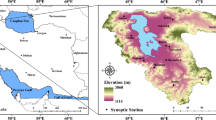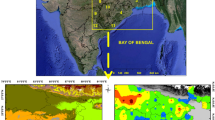Abstract
Rainfall is one of the fundamental physical parameters among the climate, which determines the environmental factors as well as the meteorological drought for a particular region. Drought is one of the most important and major natural hazards which might lead to consequences like poverty and hunger. This study analyzes rainfall variability and drought assessment spatially and temporally in the Lop Nor region, South Xinjiang, China, using Standardized Precipitation Index (SPI). For this purpose, various indices such as kurtosis, skewness, and standard deviation were calculated from annual rainfall data (1981–2018) of seven meteorological stations. For trend detection, the Mann-Kendall test was applied to both 12-month and 1-month SPIs. The highest variability was found in Yuli, Ruoqiang, and Tieganlike met-stations. The 12-month SPI results revealed extreme dry periods in the study region from 2007 to 2008, and the moderate drought was observed from 2009 to 2013. The results of the Mann-Kendall trend test for 1-month SPI indicates a more significant trend (positive) in Tieganlike and Ruoqiang, while there are fluctuations in the results of other meteorological stations. In the month of March, almost all the met-stations were found driest as the tau (τ) values were found negative in all stations. The results of 12-month SPI indicate the drying conditions in Yuli and Turpan while the wetting conditions prevailed in the remaining meteorological stations in the region.






Similar content being viewed by others
References
Ashraf M, Routray JK (2015) Spatio-temporal characteristics of precipitation and drought in Balochistan Province, Pakistan. Nat Hazards 77:229–254
Bai Q, Tian W, Feng Z et al (2010) Correlations between the precipitation of Asian arid/semiarid regions and the ocean warm pool climate. J Glaciol Geocryol 32:295–308
Bo Y, Liu C, Jiao P, Chen Y, Cao Y (2013) Hydrochemical characteristics and controlling factors for waters’ chemical composition in the Tarim Basin, Western China. Chemie der Erde Geochem 73:343–356
Braga ACFM, da Silva RM, Santos CAG et al (2013) Downscaling of a global climate model for estimation of runoff, sediment yield and dam storage: a case study of Pirapama basin, Brazil. J Hydrol 498:46–58
Chen Y, Chen Y, Xu C et al (2010) Effects of ecological water conveyance on groundwater dynamics and riparian vegetation in the lower reaches of Tarim River, China. Hydrol Process Int J 24:170–177
Dawood M (2018) Climate change and its impact on river discharge using hybrid modelling in the Hindu Kush region, Pakistan. Department of Geography. University of Peshawar.
Dawood M, Rahman A-u, Ullah S et al (2018) Spatio-temporal analysis of temperature variability, trend, and magnitude in the Hindu Kush region using Monte Carlo and Sen’s slope approaches. Arab J Geosci 11:471
Field CB, Barros V, Stocker TF et al (2012) Managing the risks of extreme events and disasters to advance climate change adaptation: special report of the intergovernmental panel on climate change. Cambridge University Press
Fu A-H, Chen Y, Li W et al (2013) Spatial and temporal patterns of climate variations in the Kaidu River Basin of Xinjiang, Northwest China. Quat Int 311:117–122
Gopalakrishnan C (2013) Water and disasters: a review and analysis of policy aspects. Int J Water Resour Dev 29:250–271
Guttman NB (1998) Comparing the palmer drought index and the standardized precipitation index1. J Am Water Resour Assoc 34:113–121
Haied N, Foufou A, Chaab S, Azlaoui M, Khadri S, Benzahia K, Benzahia I (2017) Drought assessment and monitoring using meteorological indices in a semi-arid region. Energy Procedia 119:518–529
Hao H, Ferguson DK, Chang H, Li CS (2012) Vegetation and climate of the Lop Nur area, China, during the past 7 million years. Clim Chang 113:323–338
Hayes MJ. (2000) Revisiting the SPI: clarifying the process.
Hosseinizadeh A, SeyedKaboli H, Zareie H, Akhondali A, Farjad B (2015) Impact of climate change on the severity, duration, and frequency of drought in a semi-arid agricultural basin. Geoenviron Disasters 2:23
Houghton JT, Ding Y, Griggs DJ et al (2001) Climate change 2001: the scientific basis. The Press Syndicate of the University of Cambridge
Huang J, Xue Y, Sun S, Zhang J (2015) Spatial and temporal variability of drought during 1960–2012 in Inner Mongolia, north China. Quat Int 355:134–144
Kendall MG (1975) Rank correlation measures. Charles Griffin, London, 202, 15. Chicago
Khadr M (2016) Temporal and spatial analysis of meteorological drought characteristics in the upper Blue Nile river region. Hydrol Res 48:265–276
Kobierska F, Jonas T, Zappa M, Bavay M, Magnusson J, Bernasconi SM (2013) Future runoff from a partly glacierized watershed in Central Switzerland: A two-model approach. Adv Water Resour 55:204–214
Kostopoulou E, Giannakopoulos C, Krapsiti D, et al. (2017) Temporal and spatial trends of the standardized precipitation index (SPI) in Greece using observations and output from regional climate models. Perspectives on Atmospheric Sciences. Springer, 475-481.
Lamond J, Penning-Rowsell E (2014) The robustness of flood insurance regimes given changing risk resulting from climate change. Clim Risk Manag 2:1–10
Li J, Cook E, Chen F et al (2010) An extreme drought event in the central Tien Shan area in the year 1945. J Arid Environ 74:1225–1231
Li Q, Chen Y, Shen Y, Li X, Xu J (2011) Spatial and temporal trends of climate change in Xinjiang, China. J Geogr Sci 21:1007–1018
Liu Y, Ren L, Hong Y, Zhu Y, Yang X, Yuan F, Jiang S (2016) Sensitivity analysis of standardization procedures in drought indices to varied input data selections. J Hydrol 538:817–830
Lloyd-Hughes B, Saunders MA (2002) A drought climatology for Europe. Int J Climatol J Royal Meteorol Soc 22:1571–1592
Ma C, Wang F, Cao Q et al (2008) Climate and environment reconstruction during the medieval warm period in Lop Nur of Xinjiang, China. Chin Sci Bull 53:3016
Mann HB (1945) Nonparametric tests against trend. Econometrica: Journal of the Econometric Society 245–259
McKee TB, Doesken NJ and Kleist J. (1993) The relationship of drought frequency and duration to time scales. Proceedings of the 8th Conference on Applied Climatology. American Meteorological Society Boston, MA, 179-183.
Mitchell J, Dzerdzeevskii B, Flohn H, et al. (1966) Climatic change. Technical Note, No. 79. World Meteorological Organization: Geneva, Switzerland 99.
Muller JC-Y (2014) Adapting to climate change and addressing drought–learning from the Red Cross Red Crescent experiences in the Horn of Africa. Weather Climate Extremes 3:31–36
Mustafa A, Rahman G (2018) Assessing the spatio-temporal variability of meteorological drought in Jordan. Earth Syst Environ 2:247–264
Park J-H, Duan L, Kim B, Mitchell MJ, Shibata H (2010) Potential effects of climate change and variability on watershed biogeochemical processes and water quality in Northeast Asia. Environ Int 36:212–225
Rahman G, Rahman A, Samiullah et al (2018) Spatial and temporal variation of rainfall and drought in Khyber Pakhtunkhwa Province of Pakistan during 1971–2015. Arab J Geosci 11:1–13
Ranjan P, Kazama S, Sawamoto M (2006) Effects of climate change on coastal fresh groundwater resources. Glob Environ Chang 16:388–399
Shah R, Bharadiya N, Manekar V (2015) Drought index computation using standardized precipitation index (SPI) method for Surat District, Gujarat. Aquat Proc 4:1243–1249
Shahabfar A, Ghulam A, Eitzinger J (2012) Drought monitoring in Iran using the perpendicular drought indices. Int J Appl Earth Obs Geoinf 18:119–127
Shi Y, Shen Y, Kang E, Li D, Ding Y, Zhang G, Hu R (2007) Recent and future climate change in northwest China. Clim Chang 80:379–393
Shi C, Zhou Y, Fan X, Shao W (2013) A study on the annual runoff change and its relationship with water and soil conservation practices and climate change in the middle Yellow River basin. Catena 100:31–41
Sönmez FK, Koemuescue AU, Erkan A et al (2005) An analysis of spatial and temporal dimension of drought vulnerability in Turkey using the standardized precipitation index. Nat Hazards 35:243–264
Sun X-h, Zhao Y-j, Liu C-l et al (2017) Paleoclimatic information recorded in fluid inclusions in halites from Lop Nur, Western China. Sci Rep 7:16411
Umran KA (1999) Using the SPI to analyze spatial and temporal patterns of drought in Turkey. Drought Network News (1994-2001):49
Wang H, Chen Y, Pan Y, Li W (2015) Spatial and temporal variability of drought in the arid region of China and its relationships to teleconnection indices. J Hydrol 523:283–296
Wu H, Hayes MJ, Weiss A, Hu Q (2001) An evaluation of the Standardized Precipitation Index, the China-Z Index and the statistical Z-Score. Int J Climatol J Royal Meteorol Soc 21:745–758
Wu Z, Zhang H, Krause CM, Cobb NS (2010) Climate change and human activities: a case study in Xinjiang, China. Clim Chang 99:457–472
Xia X, Mu G, Lei J (2002) Some new progress in scientific research on the Lop Nur Lake region, Xinjiang, China. Sci China Ser D Earth Sci 45:148–156
Xu Z, Chen Y, Li J (2004) Impact of climate change on water resources in the Tarim River basin. Water Resour Manag 18:439–458
Yan J, Changming L, Hongxing Z, et al. (2010) Responses of river runoff to climate change based on nonlinear mixed regression model in Chaohe River Basin of Hebei Province, China.
Yang M, Yan D, Yu Y et al (2016) SPEI-based spatiotemporal analysis of drought in Haihe River Basin from 1961 to 2010. Adv Meteorol:2016
Ye W, Dong G, Yuan Y, Ma Y (2000) Climate instability in the Yili region, Xinjiang during the last glaciation. Chin Sci Bull 45:1604–1609
Yilmaz B (2019) Analysis of hydrological drought trends in the gap region (southeastern Turkey) by Mann-Kendall test and Innovative Şen method. Appl Ecol Environ Res 17:3325–3342
Yuan Y, He Q, Zhang J et al (2003) The primary research of climate change features and their causes for the last 40 years in Xinjiang. Ecosystems Dynamics, Ecosystem-Society Interactions, and Remote Sensing Applications for Semi-Arid and Arid Land International Society for Optics and Photonics:373–379
Zhang Q, Liu C, Xu C-y et al (2006) Observed trends of annual maximum water level and streamflow during past 130 years in the Yangtze River basin, China. J Hydrol 324:255–265
Zhang Q, Xu C-y, Gemmer M et al (2009a) Changing properties of precipitation concentration in the Pearl River basin, China. Stoch Env Res Risk A 23:377–385
Zhang Q, Xu C-Y, Zhang Z (2009b) Observed changes of drought/wetness episodes in the Pearl River basin, China, using the standardized precipitation index and aridity index. Theor Appl Climatol 98:89–99
Zhang Q, Xu C-Y, Tao H, Jiang T, Chen YD (2010) Climate changes and their impacts on water resources in the arid regions: a case study of the Tarim River basin, China. Stoch Env Res Risk A 24:349–358
Zhang Q, Li J, Singh VP, Bai Y (2012) SPI-based evaluation of drought events in Xinjiang, China. Nat Hazards 64:481–492
Zhao S, Cong D, He K, Yang H, Qin Z (2017) Spatial-temporal variation of drought in China from 1982 to 2010 based on a modified temperature vegetation drought index (mTVDI). Sci Rep 7:17473
Zhong W, Bin Xue J, Shu Q, Guo Wang L (2007) Climatic change during the last 4000 years in the southern Tarim Basin, Xinjiang, northwest China. J Quat Sci 22:659–665
Funding
This research work was supported by the National Natural Science Foundation (NNSF) of China (Grant No. 41877448).
Author information
Authors and Affiliations
Corresponding author
Additional information
Responsible Editor: Zhihua Zhang
Rights and permissions
About this article
Cite this article
Ullah, I., Yuanjie, Z., Ali, S. et al. Rainfall and drought variability in spatial and temporal context in Lop Nor region, South Xinjiang, China, during 1981–2018. Arab J Geosci 13, 438 (2020). https://doi.org/10.1007/s12517-020-05431-6
Received:
Accepted:
Published:
DOI: https://doi.org/10.1007/s12517-020-05431-6




